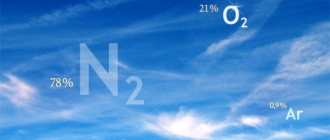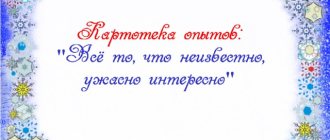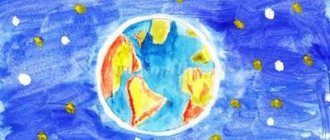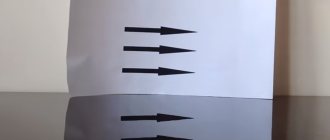Card index of experiences on a walk at different times of the year
Galina Satosova
Card index of experiences on a walk at different times of the year
Autumn
"The sun dries things out"
Goal: observe the sun's ability to heat objects.
Procedure of the experiment : Hang the doll's underwear in the sun and observe how quickly it dries; wet the sand in the sandbox and watch how it dries during the walk . Touch the bricks from which the kindergarten building is built, on the sunny and shady sides.
Conclusion: the sun heats objects.
"Properties of wet sand"
Purpose: to introduce the properties of sand
Material: sand, molds
Procedure of the experiment : pour dry sand into the molds, turn them over, see what happens. Sprinkle a stream of sand onto your palm. Then wet the sand and do the same operations.
Conclusion: wet sand can take any desired shape until it dries. When sand gets wet, the air between the sand grains disappears and the wet sand sticks together.
"Rainbow"
Goal: to introduce rainbows as a natural phenomenon.
Material: basin with water, mirror
Progress of the experiment : the teacher places a mirror in the water at a slight angle. It catches a ray of sunlight with a mirror and directs it to the wall. Turns the mirror until a rainbow appears on the wall. Water acts as a prism, decomposing the white color into its components. What does the word "rainbow"
?
What is an "arc"
? What is she like? Show the arc with your hands. From the ground, a rainbow resembles an arc, but from an airplane it appears to be a circle.
"Storm"
Goal: to prove that wind is air movement.
Progress of the experiment : children make sailing boats. Place them in containers with water. Children blow on the sails, the boats sail. Large ships also move thanks to the wind .
Questions: What happens to the boat if there is no wind? What if the wind is very strong? (a storm begins, and the boat may suffer a real shipwreck)
Conclusion: wind is the movement of air.
“There is air in the soil, there is air in the water”
Goal: to reinforce the idea that there is air in soil and water.
Procedure : take two glasses of water . Throw a piece of soil into one glass. Air bubbles will appear on the surface. Take another glass and a straw: lower one end of the straw into the water, and gently blow on the other.
Conclusion: we exhaled air, it is visible in the water in the form of bubbles.
"Air is invisible"
Purpose: to introduce the properties of air (it has no specific shape, spreads in all directions, has no odor of its own); develop the ability to establish cause-and-effect relationships based on basic experimentation.
Progress of the experiment : the teacher offers to take (consistently)
scented napkins, orange peels, garlic and feel the odors spreading in the room.
Conclusion: Air is invisible, but it can transmit odors over a distance.
"Flying Seeds"
Goal: to introduce children to the role of wind in plant life
Progress of the experiment : give the children one “flying”
and one
“flightless”
seed each.
Offer to raise your hands as high as possible and simultaneously release both seeds from your hands (for example, beans and maple, birch seeds)
Conclusion: seeds have different adaptations for flight, the wind helps the seeds move
"Plant water requirements"
Goal: to form children’s ideas about the importance of water for the life and growth of plants
Progress of the experiment : one flower is selected from the bouquet, you need to leave it without water. After some time, they compare a flower left without water and flowers in a vase with water: how are they different? Why did this happen?
Conclusion: plants need water, without it they die
"Street Shadows"
Goal: to show experimentally how a shadow is formed, its dependence on the light source and the object, and their relative position. Children look at their shadows. When does the shadow appear?
(When there is a light source)
.
What is a shadow? Why does it form (This is a dark spot)
It is formed when light rays cannot pass through an object, there are much fewer light rays behind this object, so a spot appears)
Conclusion: A shadow appears in the presence of light and an object; the outlines of the object and the shadow are similar; the higher the light source, the shorter the shadow; the more transparent the object, the lighter the shadow.
"Flight of Dandelion Seeds"
Goal: find out what determines the direction of flight of dandelion seeds.
Carefully pick the head of a white dandelion and blow on it, see how the dandelion's air parachutes fly away, how far they will fly; blow harder and determine which seeds fly further.
Conclusion: the flight of dandelion seeds depends on the strength of the blow; those seeds that are on top fly further.
“Why don’t ships sink?”
Goal: determine the properties of objects.
Place metal objects into the puddle and watch them sink. Place a tin can in the water, gradually filling it with metal objects. The bank remains afloat.
Conclusion: the jar does not sink because the area of contact between the bottom of the jar and the water is greater than the area of contact of any object with the water, so individual objects placed in the water sink.
"Steam is also water"
Goal: to introduce children to some of the properties of water.
Take a mug of boiling water so the children can see the steam. Place glass over steam. Water droplets form on the glass.
Conclusion: Water turns into steam, and steam then turns into water.
"Air Movement"
Purpose: to show that although air is invisible, it can be felt.
Invite children to wave their hand in front of their face. What does it feel like? Blow into your hands. How did you feel? All these sensations are caused by air movement.
Conclusion: air is not “invisible”; its movement can be felt when fanning your face.
“Air - where does it come from?”
Goal: make sure there is air everywhere.
Slowly release the air from the balloon. If you put your hand under the stream of escaping air, you can feel it. Air is constantly moving. Air movement is wind. When inflating a balloon, we ask the children a question: what do we inflate the balloon with? (by air)
. Where does it come from? Invite the children to cover their nose and mouth with their hands and not breathe. Find out what they felt during this?
Conclusion: A person also has air with which we fill a balloon when we exhale. If a person stops breathing for a while , he experiences discomfort and begins to suffocate, which means it is impossible to live without air.
“Soil condition depending on temperature”
Goal: to identify the dependence of soil condition on weather conditions.
On a sunny day, invite the children to look at the earth, touch it with their hands, what it is like: warm (it was heated by the sun, dry (crumbles in their hands, color (light brown)
.
Water the soil with a watering can (conditional rain)
and offer to touch it again and examine it. The earth has darkened, it has become wet, and when you press on it, it sticks and gathers into lumps. The cold water made the soil as cold as cold rain.
Conclusion: Changes in weather conditions lead to changes in soil conditions.
"Flight of Feathers"
Goal: find out if all feathers are capable of flying.
Offer the children two feathers. The flight feather is for flight. Down - for keeping birds warm. Children throw feathers into the air and watch them fly.
Conclusion: A down feather stays in the air longer and is lighter than a flight feather.
"Hello, wind!"
Purpose: to show children the movement of air, its ability to be invisible.
The children approach the puddle. This is the Sea"
. Children are “winds”. They blow on the puddle. What happens? The stronger you blow, the bigger the waves. Children lower boats with sails into the water, blow, and the boats float. What happens to boats if the wind is very strong?
Conclusion: Air is invisible, but its movement can be felt and felt.
Winter
"Transparency of Ice"
Purpose: to introduce the properties of ice
Procedure the window overnight. In the morning, examine with your children how frozen objects are visible through the ice.
Conclusion: objects are visible through ice because it is transparent
"First snow"
Goal: find out how quickly the same amount of snow on your palm or mitten will melt.
Make two snowballs, put one in your mitten and hold the other in your hand. Draw a conclusion.
Conclusion: Snow in your palm will quickly turn into water from the warmth of your palm.
"What is ice"
Goal: Find out how water turns into ice.
Take two containers with the same amount of water. One container is taken outside, and the other is left in the group. The next day - in one container the water turned into ice, so it stood on the street; in the other container the water was at room temperature and no ice formed.
Conclusion: Water turns into ice at low air temperatures.
"Transparency of Ice"
Purpose: Observing ice, identifying its properties.
Invite the children to walk along the edge of the ice and find out why it crunches. (Where there is a lot of water, the ice is hard, durable, and does not break underfoot)
. To make sure that the ice is transparent, you need to place various objects in a container with water and put them outside. In the morning we examine it and come to the conclusion that all the objects that were lowered into the water are visible through the ice.
Conclusion: Objects are visible because the ice is transparent.
"Water and Snow"
Goal: through an experiment, to consolidate children’s knowledge that water can have different states.
Add ice and snow to the group and find out which melts faster. Take three containers with loose snow, compacted snow and ice.
Conclusion: Loose snow will melt first, then compacted snow, and ice will melt last.
"The protective properties of snow"
Goal: to introduce children to the properties of snow.
Place containers with the same amount of water on the surface of the snowdrift, bury them shallowly in the snow, and bury them deep in the snow. Observe the containers during the walk and draw a conclusion .
Conclusion: The deeper the container with water is, the warmer the water will be. The coldest water will be in a container standing on the surface of a snowdrift. The roots of plants under the snow and soil are warm. The more snow, the warmer the plant.
"The Melting and Freezing of Water"
Goal: to develop observation skills, the ability to compare, analyze, generalize, and establish experimentally cause-and-effect relationships.
Children (one of them wearing mittens)
suggest taking an ice cube and watching the ice melt and turn into water.
Compare who melts the ice faster - who held it in mittens or with bare hands. Find the cause of ice melting and different melting rates .
Conclusion: ice melts and turns into water upon contact with heat. Ice melts faster in bare hands, and slower in mittens, because the mittens separate the heat and cold of the ice.
"Properties of Snow"
Goal: to continue to introduce children to the properties of snow, to develop the ability to see beauty in winter nature.
Consider the snowflakes. What are they? What are they like? What is the best way to view them?
Conclusion: There are no identical snowflakes in nature.
"Make a Snowball"
Goal: to lead to an understanding of the relationship between the state of snow and air temperature (plasticity depends on humidity, and humidity depends on air temperature)
On a frosty day, invite children to make snowballs (note that this is impossible)
.
Bring this snow to the group on the same day, after a while make snowballs and it turns out that it is easy to do.
Conclusion: The snow has become sticky because its humidity has changed.
"Depth of Snow"
Goal: to establish a connection between the strength of the wind and the shape and location of the snowdrift; measure the depth of the snowdrifts before and after snowfall using a conventional yardstick.
After a snowfall, measure the depth of the snowdrifts in different places . Explain to the children that people have established the meter as a conventional measure of length, show the children and measure the depth of the fallen snow in different places .
Conclusion: The higher the snowdrift, the greater the depth.
"Ice is solid water"
Goal: continue to become familiar with the properties of water.
Bring icicles to groups. Place them in containers, each separately. Watch the icicles melt. If the icicles are of different sizes , then pay attention to which one will melt faster.
Conclusion: Ice is solid water.
"Whose traces"
Goal: broaden horizons, cultivate curiosity.
Walk, run, jump on one leg, on two legs, on toes, on heels in fresh snow. Look at the tracks of birds and animals.
Conclusion: Different people leave different traces . The tracks of birds and animals also differ from each other.
"White birch"
Goal: to continue to introduce children to the tree, which has become a symbol of Russia.
Draw the children's attention to the birch trunk, determine in which place the trunk is widest, in which place it is narrowest. The children hug the tree, try to pull the tree out, but it doesn’t work. If you stick a twig in and try to pull it out, it’s easy to do.
Conclusion: the tree stands upright and is firmly held in the ground by its roots, so the birch does not fall.
Spring
"Water and Snow"
Goal: experimentally fix various states of water.
Add snow and ice to the group. Where will the water melt faster? In one bucket there is loose snow,
in another - compacted, in the third - ice.
Conclusion: Loose snow will melt first, then the snow in the compacted bucket will melt, the ice in the last bucket.
“Dependence of the growth of grass and trees on the illumination of the habitat”
Purpose: to show the dependence of plant growth on plant illumination.
Draw the attention of children that on trees and shrubs located in well -warmed and protected from the wind places, leaves and flowers bloom earlier than on similar plants located in the shade. The same pattern is observed for grasses: in places warmed by the sun , grass appear earlier and grow faster.
Conclusion: The more sun, the faster the grass grows and the leaves bloom on the trees.
"The sun dries things out"
Purpose: to identify the ability of the sun to heat objects.
Hang the doll's clothes to dry in the area, wet the sand with water, and spill the water on the asphalt. Touch the kindergarten building on the sunny and shady sides.
Conclusion: The brighter the sun shines, the faster the laundry, sand, and asphalt dry.
"Water permeability of sand and clay"
Goal: to develop the child’s cognitive interest in the process of experimentation.
Pour water into the hole with sand. What has he become? (Wet, wet)
.
Where did the water go? (She hid between the grains of sand). Which sand is easier for a stick to penetrate? (In dry)
.
Pour water onto the ground. How is water absorbed? (Slower than in sand. Some of the water remains on the clay.)
It is easier to stick a stick into wet clay than into dry clay.
Conclusion: Sand allows water to pass through faster than clay.
“Green grasshopper on green paper. Green grasshopper on white paper"
Try to catch a grasshopper and examine it on green paper and then on white paper. Draw a conclusion.
Conclusion: The body shape and color of an insect are the insect’s protective devices.
“Finding out the reason for the emergence of worms during rain”
Goal: to establish why worms crawl to the surface when it rains.
Pour water into the box with soil, stones, sticks and earthworms. Water displaces air from the free space, worms begin to crawl to the surface of the earth.
Conclusion: Worms crawl out due to lack of oxygen in the soil.
"Insect Traces"
Goal: to continue to expand children's knowledge about the diversity of insects.
Invite the children to carefully catch a cockchafer and a large ant (after the experiment, put the insects back in place)
.
Spread a thin layer of sand onto a sheet of cardboard .
Allow the caught insects to run across the sand. Compare what traces insects leave on the sand. Conclusion: The larger the insect, the deeper the mark in the sand.
"Sand Cone"
Purpose: To demonstrate the properties of sand through experiment.
Release a handful of sand in a stream so that it falls in one place. Gradually, a cone forms at the site of the fall, growing in height and occupying an increasingly larger area at the base. If you pour sand for a long time, drifts appear in one place and then in another. The movement of sand is similar to a current.
Conclusion: Sand can move.
Summer
"Watching the Sun"
Purpose: to test the degree of heating of objects using an experiment.
Invite children to touch stones and metal objects in the morning, afternoon and evening, to find out the difference between objects .
Conclusion: Objects are hotter at noon.
"No Wind"
Take a balloon and throw it up
Conclusion: If there is no wind, the ball will fly only under the influence of the hand.
"Plant Smells"
Goal: broaden horizons, cultivate curiosity.
Rub the plucked mint leaves, onion feathers, and dill leaves with your fingers, feeling the smell.
Conclusion: Each plant smells differently.
"Water Evaporation"
Goal: to verify through experiment that the rate of water evaporation depends on the container.
Pour the same amount of water into a saucer and a transparent glass. Draw a conclusion.
Conclusion: water in a saucer evaporates faster, since the evaporating surface area of the saucer is larger than that of the glass.
"Flower"
Goal: to cultivate a kind, compassionate attitude towards nature.
At the beginning of the walk, pick one flower . At the end of the walk, see what happened to him. Compare it with the flowers in the flowerbed.
Conclusion: A plant dies without water.
"Sunny Bunny"
Goal: to show through an experiment how you can repeatedly reflect the light and image of an object, that is, see it where it should not be.
Invite the children to use the “sunny bunny” to see how it turns out. Using another mirror in the place where we saw a ray of sunlight on the wall, we get another “sunny bunny” and
Conclusion: To reflect sunlight several times, you need to have several mirrors.





